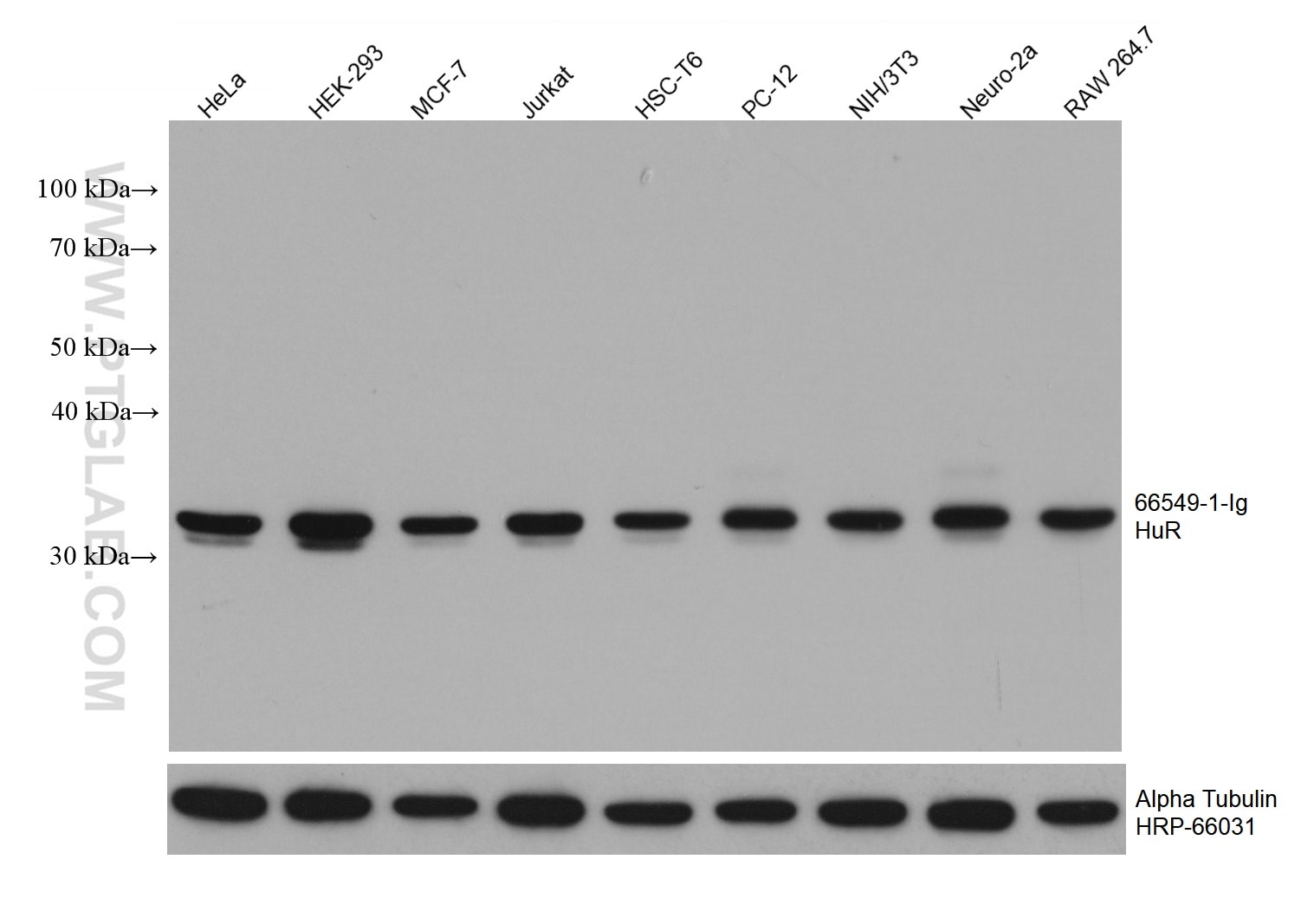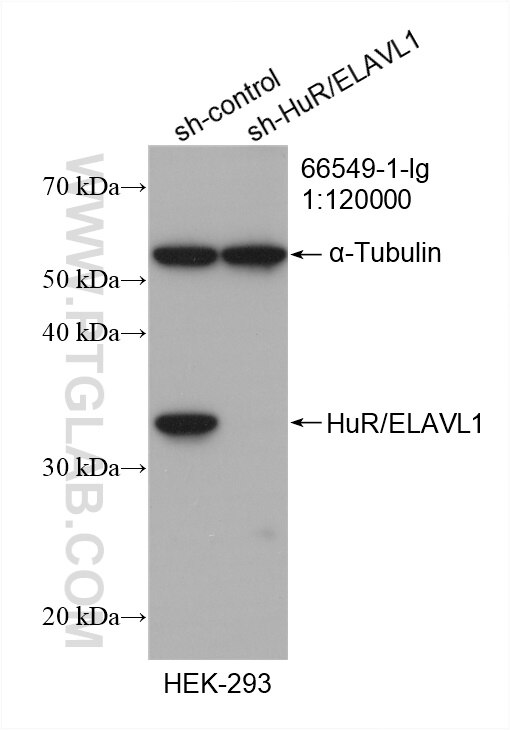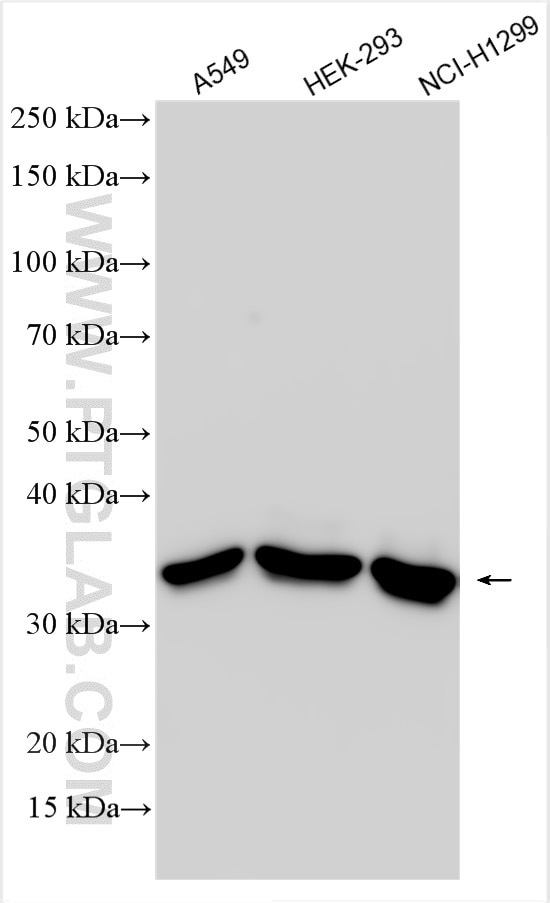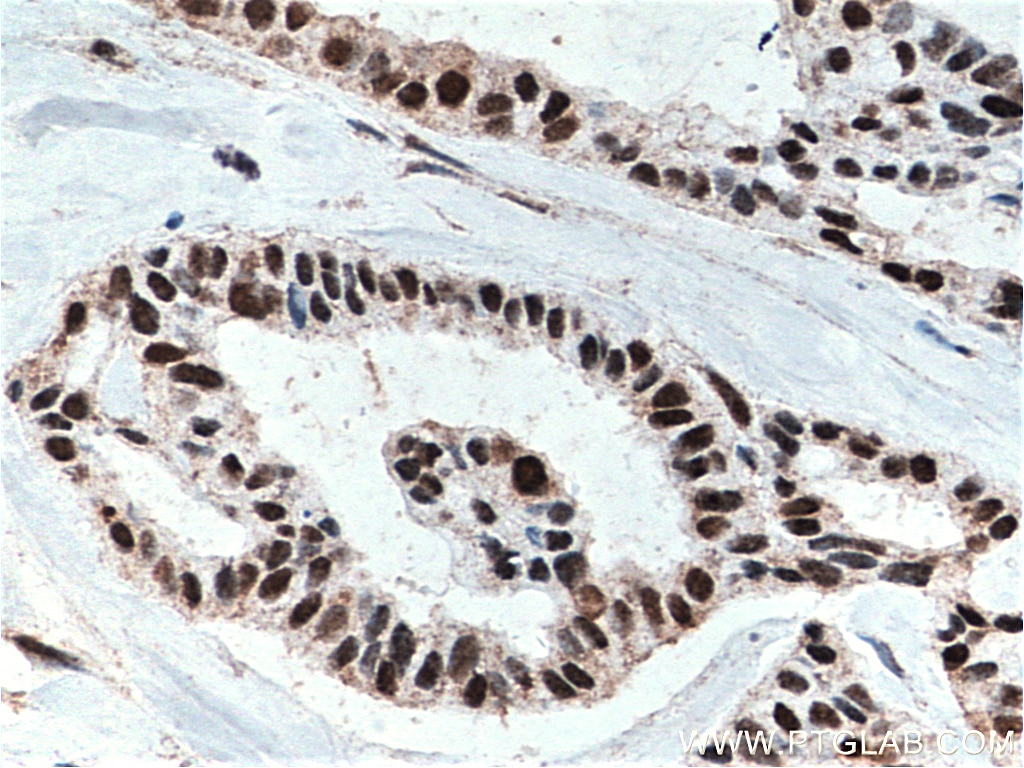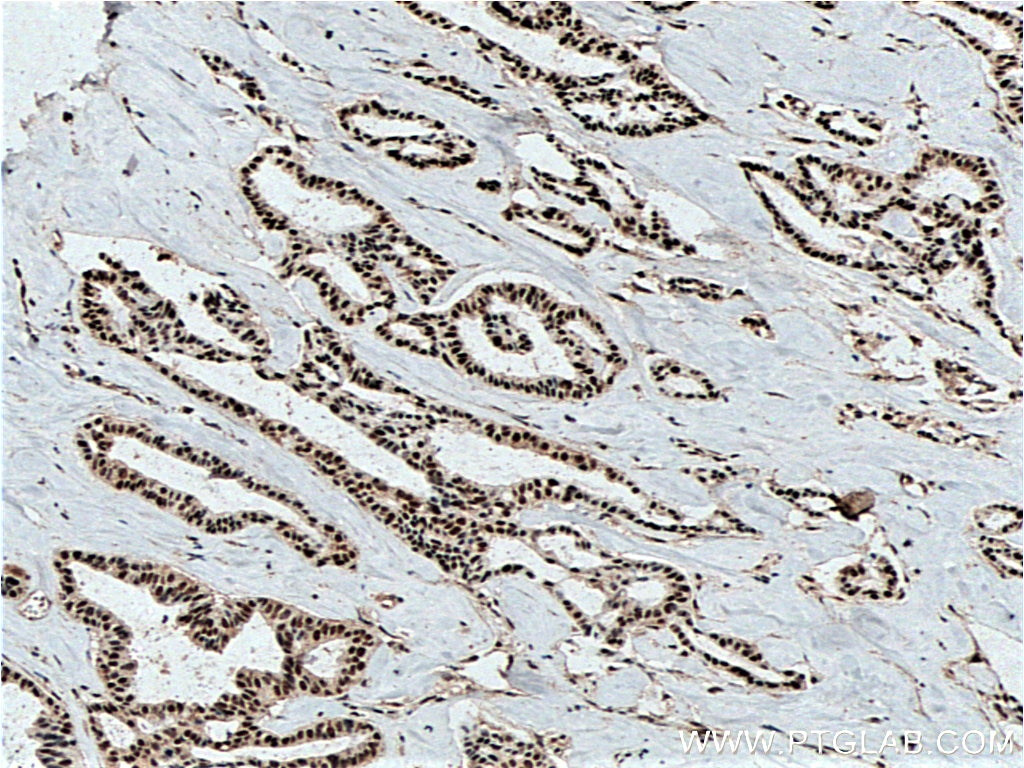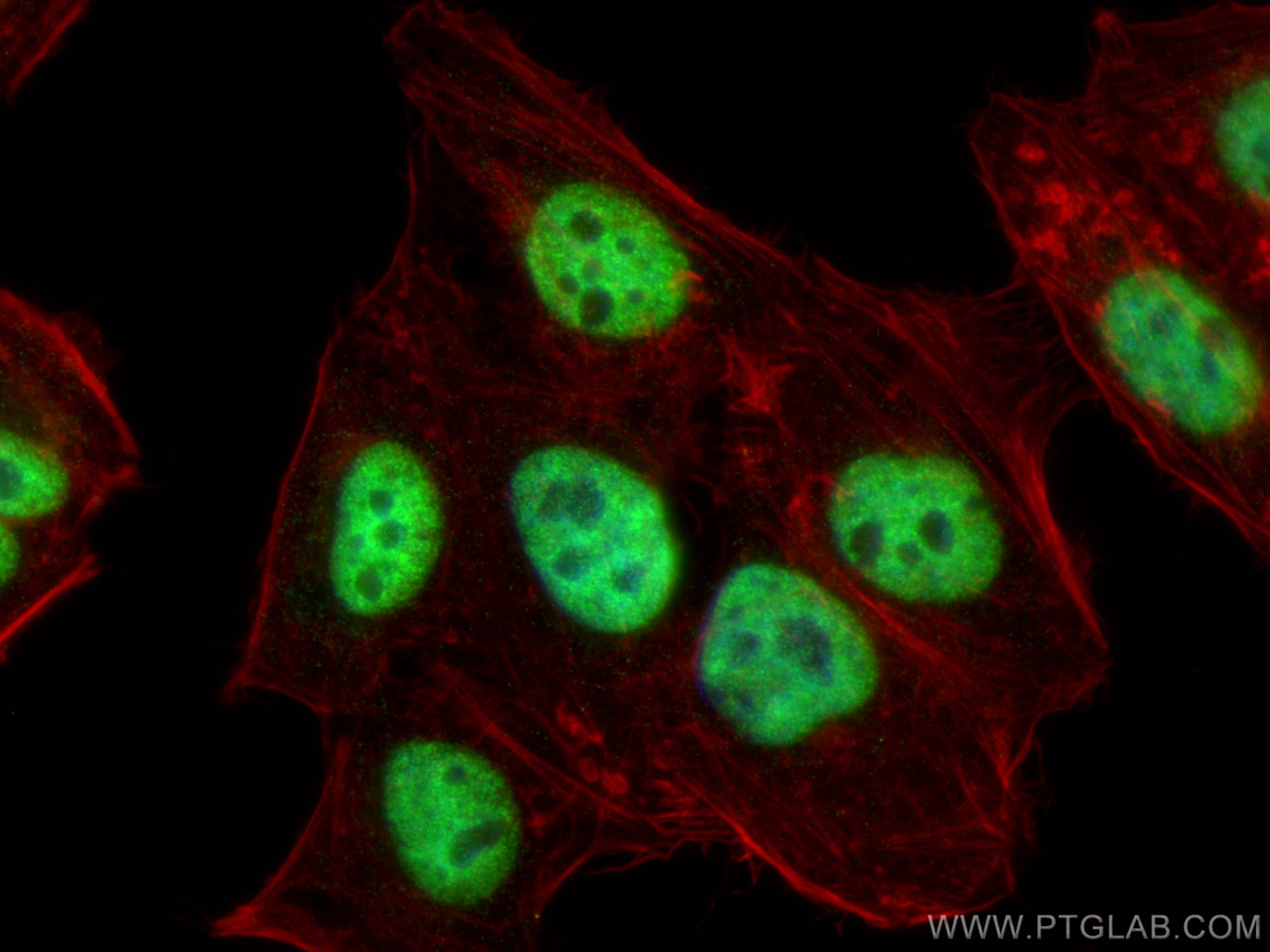Tested Applications
| Positive WB detected in | HeLa cells, HEK-293 cells, A549 cells, MCF-7 cells, Jurkat cells, HSC-T6 cells, PC-12 cells, NIH/3T3 cells, Neuro-2a cells, RAW 264.7 cells, NCI-H1299 cells |
| Positive IHC detected in | human ovary tumor tissue, human breast cancer tissue Note: suggested antigen retrieval with TE buffer pH 9.0; (*) Alternatively, antigen retrieval may be performed with citrate buffer pH 6.0 |
| Positive IF/ICC detected in | HepG2 cells |
Recommended dilution
| Application | Dilution |
|---|---|
| Western Blot (WB) | WB : 1:5000-1:50000 |
| Immunohistochemistry (IHC) | IHC : 1:500-1:2000 |
| Immunofluorescence (IF)/ICC | IF/ICC : 1:200-1:800 |
| It is recommended that this reagent should be titrated in each testing system to obtain optimal results. | |
| Sample-dependent, Check data in validation data gallery. | |
Published Applications
| KD/KO | See 1 publications below |
| WB | See 6 publications below |
| IF | See 3 publications below |
Product Information
66549-1-Ig targets HuR/ELAVL1 in WB, IHC, IF/ICC, ELISA applications and shows reactivity with Human, mouse, rat samples.
| Tested Reactivity | Human, mouse, rat |
| Cited Reactivity | human, mouse |
| Host / Isotype | Mouse / IgG2a |
| Class | Monoclonal |
| Type | Antibody |
| Immunogen |
CatNo: Ag2249 Product name: Recombinant human HuR protein Source: e coli.-derived, PGEX-4T Tag: GST Domain: 1-326 aa of BC003376 Sequence: MSNGYEDHMAEDCRGDIGRTNLIVNYLPQNMTQDELRSLFSSIGEVESAKLIRDKVAGHSLGYGFVNYVTAKDAERAINTLNGLRLQSKTIKVSYARPSSEVIKDANLYISGLPRTMTQKDVEDMFSRFGRIINSRVLVDQTTGLSRGVAFIRFDKRSEAEEAITSFNGHKPPGSSEPITVKFAANPNQNKNVALLSQLYHSPARRFGGPVHHQAQRFRFSPMGVDHMSGLSGVNVPGNASSGWCIFIYNLGQDADEGILWQMFGPFGAVTNVKVIRDFNTNKCKGFGFVTMTNYEEAAMAIASLNGYRLGDKILQVSFKTNKSHK Predict reactive species |
| Full Name | ELAV (embryonic lethal, abnormal vision, Drosophila)-like 1 (Hu antigen R) |
| Calculated Molecular Weight | 326 aa, 36 kDa |
| Observed Molecular Weight | 34-37 kDa |
| GenBank Accession Number | BC003376 |
| Gene Symbol | HuR/ELAVL1 |
| Gene ID (NCBI) | 1994 |
| RRID | AB_2881911 |
| Conjugate | Unconjugated |
| Form | Liquid |
| Purification Method | Protein A purification |
| UNIPROT ID | Q15717 |
| Storage Buffer | PBS with 0.02% sodium azide and 50% glycerol, pH 7.3. |
| Storage Conditions | Store at -20°C. Stable for one year after shipment. Aliquoting is unnecessary for -20oC storage. 20ul sizes contain 0.1% BSA. |
Background Information
ELAVL1, also named as HUR, belongs to the RRM elav family. It is involved in 3'-UTR ARE-mediated MYC stabilization. ELAVL1 binds avidly to the AU-rich element in FOS and IL3/interleukin-3 mRNAs. In the case of the FOS AU-rich element, ELAVL1 binds to a core element of 27 nucleotides that contain AUUUA, AUUUUA and AUUUUUA motifs.
Protocols
| Product Specific Protocols | |
|---|---|
| IF protocol for HuR/ELAVL1 antibody 66549-1-Ig | Download protocol |
| IHC protocol for HuR/ELAVL1 antibody 66549-1-Ig | Download protocol |
| WB protocol for HuR/ELAVL1 antibody 66549-1-Ig | Download protocol |
| Standard Protocols | |
|---|---|
| Click here to view our Standard Protocols |
Publications
| Species | Application | Title |
|---|---|---|
Biochim Biophys Acta Mol Cell Res IL-17 promotes melanoma through TRAF2 as a scaffold protein recruiting PIAS2 and ELAVL1 to induce EPHA5 | ||
Mol Cell Endocrinol ELAV-like RNA binding protein 1 regulates osteogenesis in diabetic osteoporosis: Involvement of divalent metal transporter 1. | ||
Cell Signal Butyrate mediated regulation of RNA binding proteins in the post-transcriptional regulation of inflammatory gene expression. | ||
J Int Med Res Long non-coding RNA DEPDC1-AS1 promotes proliferation and migration of human gastric cancer cells HGC-27 via the human antigen R-F11R pathway. | ||
Cell Death Dis LncGMDS-AS1 promotes the tumorigenesis of colorectal cancer through HuR-STAT3/Wnt axis
| ||
Oncol Lett Stress granules affect the sensitivity of renal cancer cells to sorafenib by sequestering and stabilizing COX‑2 mRNA |

